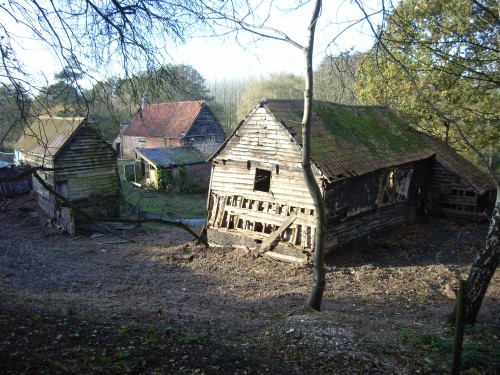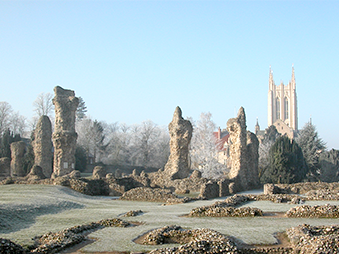Farming has been a major influence on the development of Suffolk’s landscape, both physically and socially throughout history. Farmsteads are important to Suffolk’s history and character. The different characteristics of farmsteads can also help us to understand agricultural practices and their development since the medieval period.
Introduction

(Some documents on this page may not be suitable for users of assistive technology. Request an accessible format.)
Many farm buildings became redundant in the post-war period due to changes in agricultural technology and farming practice. The survival of historic farmsteads in England is not systematically recorded, as many of these buildings are not individually listed.
Following on from a series of nationwide farmsteads characterisation projects, the team in the Suffolk Historic Environment Record (HER) have successfully completed a project to record the character and survival of all lost and existing historic farmsteads in Suffolk, thanks to funding from Historic England. View the nationwide projects at historicengland.org.uk
The aim of the project was to raise awareness of the importance of these undesignated heritage assets and improve their long-term management to ensure a sustainable future for Suffolk farmsteads.
Using historic Ordnance Survey maps, tithe maps, and aerial imagery the team have recorded 5,886 farmsteads, outfarms and field barns.
The form and location of farms is related to the needs of the rural economy and landscape character, and farm building stock reflects periods of significant development in agricultural and rural history.
Suffolk has many pre-1700 farm buildings and multi-period farmsteads where earlier buildings have been adapted. The project shows that 65% of the farmsteads in existence in the late 19th century still retain some or all of their historic form, with some regional variation across the county. Over 40% of the recorded farmsteads are still in agricultural use, and 30% of the sites have converted buildings.
The project is an invaluable source of information to mitigate development as part of the planning process as well as for future research. It will enable the potential heritage of farmsteads to be identified at an early stage in planning applications, which can inform development decisions or inform the investigation and recording of historic features.
Farmsteads in Suffolk
Original study of farmsteads in Suffolk
Previous work on the understanding our historic farmsteads in Suffolk includes a thematic study of listed farm buildings, undertaken in 1998 by Philip Aitkens and Susanna Wade Martins.
More information about buildings in Suffolk generally is available from the Suffolk Historic Buildings Group at shbg.org.uk, and the Vernacular Architecture Group at vag.org.uk.
Initial work by Historic England
As part of their wider work, Historic England are interested in how farm character differs across different areas of the country. They have produced a National Farmsteads Character Statement, which sits above preliminary character statements for different areas. Suffolk can be found in the East of England Historic Farmsteads Preliminary Character Statement.
Our project forms part of a wider national programme of mapping and assessment of farmsteads, to form a broad picture of the character of historic agricultural buildings across the UK.
You can find out more on Historic England’s webpages on characterisation and the character of farm buildings.
Farm buildings and traditional farmsteads
Historic England's website with information on historic farm buildings, publications and character statements.
Visit historicengland.org.uk »Farmsteads Character
Here you can find statements to understand more about the character of farmsteads in your area of interest.
Project Report
The Suffolk HER project builds upon the 1998 study and Historic England statement by capturing and recording all farmsteads in Suffolk, not just the listed buildings. An initial exploration of the distribution of Suffolk farmstead types against landscape type is also provided, and results of the data collection are mapped onto Natural England’s National Character Area (NCA) profiles. These are subdivisions of England based on a combination of landscape, biodiversity, geodiversity and economic activities. Information on the National Character Areas can be found at gov.uk/government/publications
Full details of our methodology and findings can be found in the full project report below. Some examples of farmsteads can be explored in our earlier blog post. A summary presentation on the project was prepared for general interest, and to share the findings with local planning authorities.
Download Summary Presentation
a summary presentation on the Suffolk Farmsteads project's methodology and results
Download Presentation (PDF) »Download Report
a full report "Farmsteads in the Suffolk Countryside" detailing the project's methodology and results
Managing Change
Suffolk, as a rural county, has many historic farm buildings. The vast majority of them are not listed buildings, but they contribute to the historic landscape and also hold valuable evidence about changing rural life. In many cases, their significance has not been systematically assessed. Where development proposals such as conversion or even demolition could potentially affect historic buildings, information should be provided so that such changes can be sympathetically managed.
Below are a list of useful resources with links to external websites:
The National Planning Policy Framework (NPPF) 2021 Chapter 16, ‘Conserving and Enhancing the Historic Environment’ gives weight to the need for balanced decisions in relation to the protection and management of non-designated heritage assets in the development process. Suffolk’s Local Planning Authorities also have policies relating to designated and non-designated assets.
Historic England 'Heritage Statements' offer advice to support planning applications.
Historic England 'Farm Buildings and Traditional Farmsteads' offers advice on looking after historic farm buildings
East Suffolk Council's 'Supplementary Planning Document (PDF)' gives advice on the Historic Environment.
East Suffolk Non-designated Heritage Assets guidance for planning applications
Babergh and Mid-Suffolk Heritage Team Standing Advice for minor development in Conservation Areas and within the grounds of Listed Buildings 2021 (PDF)
West Suffolk's guidance for planning applications
Details of Conservation and Design teams at Suffolk’s Local Planning Authorities can be found on the webpages of Babergh and Mid Suffolk District Councils, East Suffolk Council, Ipswich Borough Council, West Suffolk Council.


